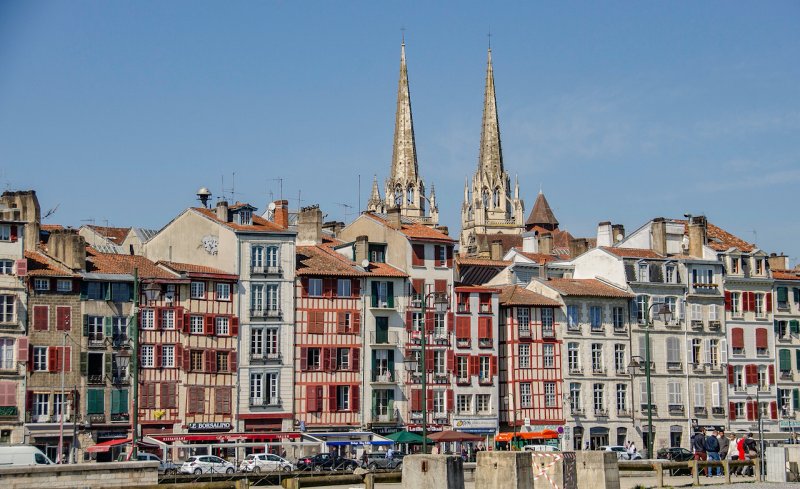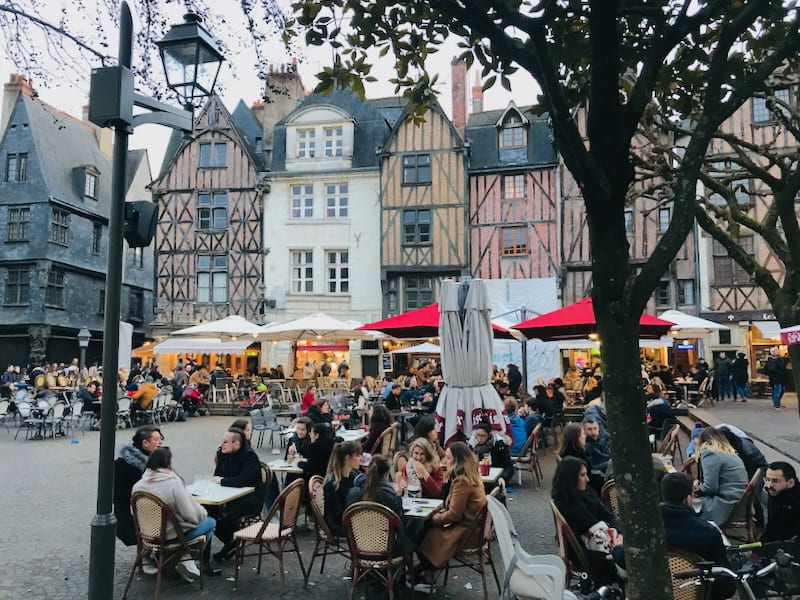Unsure about your French table manners? Click Here to download > > How to avoid these 10 food etiquette mistakes !
- Home ›
- Destinations ›
- Undiscovered France ›
- Less Visited French Cities
7 Less Visited Cities in France You Must Have On Your Radar in 2024
Published 20 January 2024 by Leyla Alyanak — Parisian by birth, Lyonnaise by adoption, historian by passion
Here are 7 cities that aren’t always on a visitor’s itinerary, yet they are accessible, fascinating and certainly worth visiting if you're looking for authentic French experiences and off-the-beaten-path destinations. Here’s why you should go!
Everyone goes to Paris, and many visitors follow on to Lyon or Bordeaux. Or the Loire Valley and southern France. And so they should.
Exquisite as these may be, a huge swathe of hidden France lies in-between, and some of these best places are crying out to be explored.
The following seven cities are among the top destinations for the French (including myself), but less visited by foreign tourists. Yet they’re stunning, and easy to get to, and I’d love you to visit and find out why I'm so passionate about them. This is the time to go, while they're still not on everyone's radar!
NOTE: Pages on this site may contain affiliate links, which support this site. See full Privacy Policy here.
7 Less-visited French cities to explore
Here are seven cities I know and love, but I always notice that French tourists outnumber foreign ones by a long shot. I get it, there are plenty of other places to visit in France, but each of these cities has something special and is worth visiting.
1. Arles
This is a small town and one of my favorite in France, and the perfect place for lovers of art and culture. It is filled with historical sites and covers three very distinct periods.
If you’re a fan of Roman ruins, you’ll be thrilled as you wander through the Arles amphitheater, inspired by Rome’s Colosseum, or Constantine’s baths, the most spectacular in Provence. The Museum of Antiquities houses such spectacular pieces as an entire, restored flat-bottomed boat, once used to ferry stones and coins up the Rhône River, and a magnificent bust of Caesar, believed to be the oldest likeness of him in existence.

 Even though the site has changed quite a bit, I still felt I was living a special moment through van Gogh's art just by standing here ©️OffbeatFrance/Leyla Alyanak
Even though the site has changed quite a bit, I still felt I was living a special moment through van Gogh's art just by standing here ©️OffbeatFrance/Leyla AlyanakIf 19th-century art is what you’re after, Arles was the home of Vincent van Gogh for 18 months, and he was prolific while he lived here, painting 187 works of art. Art lovers can follow in his footsteps by using a map available from the tourist office. Don’t be surprised if some spots in Arles look very familiar.
And then there’s the city’s contemporary vibe, with the opening in 2021 of Luma Arles. The ten-story stainless steel building was designed by architect Frank Gehry, and is architecturally surprising.
 LUMA Arles, in the soft light of dawn ©️OffbeatFrance/Leyla Alyanak
LUMA Arles, in the soft light of dawn ©️OffbeatFrance/Leyla AlyanakInside, it houses photographic exhibitions and showcases modern artists and outside, the gardens and warehouse areas are dotted with eclectic and unexpected sculptures. Fittingly, it sits across the street from France’s only university-level photography school.link
HELPFUL HINTS FOR GETTING TO ARLES
- Fly into Marseille and take the train to Arles – less than an hour
- Local trains from Nîmes, Avignon or Montpellier
- Several direct trains daily from Paris-Gare de Lyon to Arles (check schedules here)
- Drive from Paris along the A6, which goes through Lyon (check rental prices here)

2. Bayonne
Bayonne is a picturesque city, the capital of one of the most unique corners of France: the Basque country, hidden away in the country’s southwestern corner.
This unique area is a continuation of the Basque region just over the Spanish border: Spain has four Basque provinces and France has three, but there are plenty of social and linguistic similarities.
Basque culture is a major draw here, with everything from Basque dances and singing to sports (Jai Alai and Pelote) to the Basque language, the oldest language still spoken in Europe but with no known roots. When it comes to culture, the Basque History Museum will enlighten you.
This is a land of delicious food (Basque chefs are revered worldwide), of wood-trimmed houses and an eclectic history that includes being ruled by England for 300 years.
 Typical of the region is Gateau Basque, or Basque cake ©OffbeatFrance
Typical of the region is Gateau Basque, or Basque cake ©OffbeatFrance Bayonne ham, so prized in the region, of course, but beyond as well
Bayonne ham, so prized in the region, of course, but beyond as wellUnexpectedly, this city is known as France’s Capital of Chocolate, the first cocoa beans having been brought in by Jews fleeing Spain at the time of the Catholic Inquisition.
Bayonne is also renowned for its air-cured ham, from pigs raised high in the mountains above the coast. Use my Basque itinerary to explore both the coast and the interior.
 Hot chocolate at Cazenave, one of the oldest chocolate makers in Bayonne ©️OffbeatFrance
Hot chocolate at Cazenave, one of the oldest chocolate makers in Bayonne ©️OffbeatFrance Houses typical of Bayonne's Basque architecture @OffbeatFrance/Anne Sterck
Houses typical of Bayonne's Basque architecture @OffbeatFrance/Anne SterckThe buildings are particularly striking, with their deep reds and greens and blues, so typical of the region. The city’s architecture and cobblestones make it a pleasure to wander around.
GETTING TO BAYONNE
- Take the direct train from Paris (check schedules here)
- Trains are also frequent from Toulouse, Bordeaux, Pau and Dax
- To drive, follow along the A10 through Bordeaux (check car rental prices here)
- The coastal resort of Biarritz is a 15min drive away and has an international airport with scheduled and low-cost flights from other French or European cities

3. Tours
Many people visit the Loire Valley on day trips from Paris, but please consider spending at least one night if you can to explore a few extra chateaux – Chenonceau Castle is less than half an hour by train.
From the medieval architecture and twisted streets in the Old Town to the half-timbered houses that surround the café-filled Place Plumereau (often called Place Plum’ or Plume), Tours is garlanded with history, a charming town that has acted as France’s capital several times in the past.
 The delightful Place Plumereau is always crowded with students, even on a cold February day ©️OffbeatFrance/Leyla Alyanak
The delightful Place Plumereau is always crowded with students, even on a cold February day ©️OffbeatFrance/Leyla AlyanakAn example of this history is the Tours Cathedral, officially the Cathédrale Saint-Gatien, an architectural marvel that dates back to the 12th century and still has its original stained glass windows.
 Spectacular woodworking skills exhibited at the Musée du Compagnonnage in Tours ©️OffbeatFrance/Leyla Alyanak
Spectacular woodworking skills exhibited at the Musée du Compagnonnage in Tours ©️OffbeatFrance/Leyla AlyanakOne of my favorite sights in Tours is the Musée du Compagnonnage, dedicated to French crafts guilds that range from wood-carving to metal works. The museum represents the work of the Compagnons du Tour de France, originally journeymen touring France as part of their trades apprenticeship. Examples of their work are exhibited in the museu, with the kind of fine workmanship rarely seen these days.
GETTING TO TOURS
- The best way is to take the train, which takes between 1.5-2.5 hours (check schedules here). Be aware that Tours has two train stations, Tours and St Pierre des Corps, but there are shuttle trains to Tours: the ride takes 5 minutes and there are nearly 50 train shuttles a day
- By car, the A10 will take you around 2.5 hours (check car rental prices here). Although the train ride is shorter, a car is useful if you plan on visiting the Loire Valley chateaux.

4. Dijon
You know the mustard that carries the name of this French city, but how well do you know the city?
There’s something playful about it. If you like games or following clues, you’ll have fun discovering Dijon by following the Owl’s Trail, bronze arrows embedded in the sidewalks that lead you from one city attraction to the next. It’s a fun way to discover everything from the unique Museum of Burgundian Life to the Tower of Philippe le Bon (and its 316 steps). I had to stop along the way but the magnificent view was worth it!
 Part of the view you'll get from the top of the tower ©️OffbeatFrance/Leyla Alyanak
Part of the view you'll get from the top of the tower ©️OffbeatFrance/Leyla AlyanakThe city of Dijon has a deep history as the capital of the Dukes of Burgundy, who ruled Burgundy for six centuries until it was annexed by France in 1477. Burgundy then was far larger than it is today, stretching from its present boundaries into northeastern France and all the way to the Netherlands.
The ducal palace still stands, and is now home to the town hall, the tourist office and the Museum of Fine Arts, which houses the Dukes’ spectacular tombs.

Dijon is, of course, in the heart of Burgundy so this is a great place to take a masterclass with a sommelier and learn all about the rich-bodied burgundies.
GETTING TO DIJON
- The easiest is to take a train from either Paris or Lyon (check schedules here)
- You can drive in just over 3 hours from either Paris or Lyon (check car rental prices here)

5. Grenoble
While you’ve often heard the name of Grenoble, have you visited?
Not that many foreigners visit, hurried as they are to reach the ski resorts in the surrounding countryside, like La Plagne or Val Cenis. While this is commendable, rushing past means missing a beautiful town.
Grenoble’s setting is impossibly gorgeous, bordered to the west by the Isère River and to the north by the Drac. And while rivers are wonderfully picturesque, Grenoble’s Alpine backdrop will take your breath away.

Ride the “bubbles”, more formally known as the Bastille cable car, and admire the view as you go up. And when you reach the Bastille Fortress at the top, the view will be even better.
Grenoble is home to outstanding museums, including fine arts, a military museum, and the spectacular archeological museum, which tracks 2000 years of Grenoble’s history.

If you’re into fashion or crafts, don’t miss the Gants Lesdiguières shop, where the last glove-maker of Grenoble still cuts each glove by hand.
GETTING TO GRENOBLE
- Grenoble is just over an hour’s drive from Lyon along the A48 (click to rent a car)
- There are several direct trains from Paris to Grenoble each day, along with trains from nearby cities like Annecy, Geneva, Chambery or Lyon (check schedules here)

6. Nantes
Nantes in northern France was once the country's largest slave port, a way station between Africa and the New World. Now, the capital of Brittany is acknowledging its history and owning its past.
The 15th century castle of the Dukes of Brittany, once owned by Anne of Brittany, is dedicated to the city’s history, including slavery. The castle is worth visiting for its significance, and at night it glows with a light show!
After your visit, follow the 11 urban panels to the Memorial to the Abolition of Slavery, a public space built along the banks of the Loire and a particularly emotional reminder of slavery.
 Part of the Memorial, along the Loire shoreline ©️OffbeatFrance
Part of the Memorial, along the Loire shoreline ©️OffbeatFranceWalking along the water, don’t be surprised if you hear the trumpeting of an elephant − and then see a giant pachyderm roll by. I say roll because it is a mechanical elephant on wheels, part of an artistic project that has spread across Nantes and beyond − and definitely worth seeing (and riding).
 The mechanical elephant, looks like one and certainly sounds like one! ©️OffbeatFrance/Leyla Alyanak
The mechanical elephant, looks like one and certainly sounds like one! ©️OffbeatFrance/Leyla AlyanakFor lunch or dinner, head for La Cigale, an Art Nouveau brasserie filled with mirrors and ceramics that will keep intruding on your meal in the nicest possible way − they’re so beautiful you won’t be able to take your eyes off them.

GETTING TO NANTES
- Direct trains from Paris-Montparnasse to Nantes take well under two hours (check schedules here)
- By car, take the A11 to Nantes – the drive should take less than four hours (check car rental prices here)

7. Nancy
Often nicknamed “Little Paris”, Nancy’s main attraction is its architecture. Yet in my opinion, it is one of the most underrated cities in France.
Its monumental side is reflected in the enormous Place Stanislas, voted France’s favorite square a few years ago which is, along with two other squares (Place de l’Alliance and Place de la Carrière), protected as a UNESCO World Heritage Site. They are considered among the most harmonious urban landscapes of the Enlightenment.
Place Stanislas is ringed with cafés and restaurants. When the weather is warm, the square is a hive of activity but if you’d rather walk around, the gilded wrought-iron gates are works of art in themselves.
 Place Stanislas at night ©️OffbeatFrance/Leyla Alyanak
Place Stanislas at night ©️OffbeatFrance/Leyla AlyanakThe other style Nancy is known for is Art Nouveau. The city is the center of an art movement known as the Ecole de Nancy, an art movement of the Belle Epoque created by the proximity of the German border – with many French artists returning to France after its defeat by Prussians in the Franco-Prussian war.
 Stained glass window by Jacques Gruber at the Museum of the École de Nancy ©️OffbeatFrance/Leyla Alyanak
Stained glass window by Jacques Gruber at the Museum of the École de Nancy ©️OffbeatFrance/Leyla AlyanakVisit the stunning Villa Majorelle, Nancy’s first entirely Art Nouveau villa, built by all the big name artisans of the era. And don’t miss the museum of the École de Nancy, with everything from furniture to ceramics.
If you’re a true art fan, head back to Place Stanislas and the Museum of Fine Arts: in the basement is an exquisite collection of Daum crystal, with shapes straight out of the Art Nouveau school.
GETTING TO NANCY
- Plenty of direct trains will take you from Paris to Nancy in under two hours (check schedules here)
- To drive, follow the N4 – the drive is around four hours (check car rental prices here)
Before you go...
These seven cities are each, in their own way, authentic representations of France, from the mustard and wines of Burgudy to the Gallo-Roman remnants in Arles to the Alps surrounding Grenoble.
And like these seven, there are dozens of large towns or small cities that are simply waiting for you to explore them. Here are some of France's most beautiful cities, in case you haven't visited them all!

